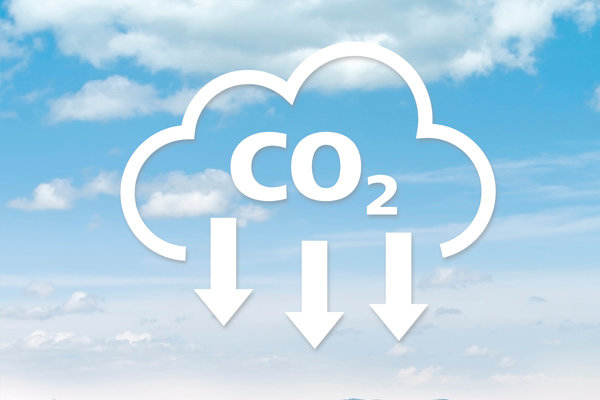

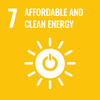
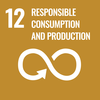
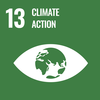
Our CO2 footprint
Starting in the reporting period 2021, EVVA has defined “emissions” as a key theme (more on our management approach can be found on the Energy & Emissions Overview page). We have had the emission of the headquarters analysed according to Scope 1, Scope 2, Scope 3. The following check was carried out by the external sustainability agency denkstatt. Our emissions almost exclusively concern CO2. Fluorine gases (contained in refrigerants for air conditioning systems) are also considered under Scope 1 in the “refrigerants” section.
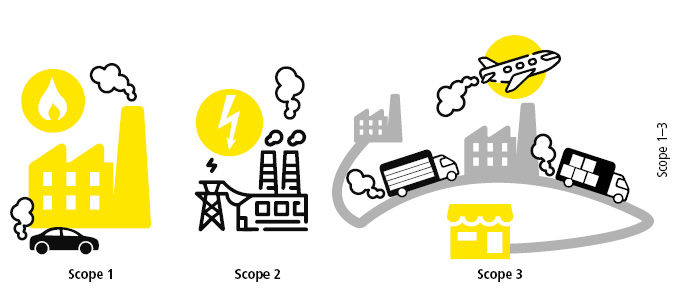
What does Scope 1 to 3 mean?
These refer to the direct, indirect, and extended emissions of a company. Scopes 1 and 2 can often be controlled by a company itself, but Scope 3 is much more challenging.
Scope 1: Direct emissions within the company. At EVVA, these are 373 tons in 2021. These include natural gas for heating (203 t), refrigerants for cooling (no additional quantities required in 2021), and diesel (165 t) and gasoline (5 t) for the fleet.
Scope 2: Indirect emissions. This category includes the electricity purchased by EVVA for production, offices, etc. with 472 tons in 2021.
Scope 3: Extended emissions. Scope 3 includes all emissions that a) arise in the upstream value chain (upstream, i.e., towards the company), and b) arise in the downstream value chain (downstream, i.e., away from the company). This scope includes the largest share of emissions, across all sectors, including at EVVA with around 95% (15,009 tons, see the following chart for a detailed list). Examples of Scope 3:
Upstream:
- Purchased materials – especially brass, our main production material. This is by far the largest Scope 3 factor at EVVA.
- Energy consumption required by the manufacturer/supplier (brass manufacturer, cloud service provider, etc.)
- Investments in infrastructure such as machinery, etc.
- Transportation of materials/goods from suppliers to EVVA
- Waste produced (in production, disposal, packaging…)
- Business travel (flight kilometres…)
- Commute of employees to work
Downstream:
- Transportation of products from EVVA to business partners/customers
- Emissions that arise during use of the products. This factor does not weigh heavily at EVVA (see the following detailed chart), because our mechanical access systems do not consume energy at the customer’s site and our electronic access solutions also have extremely low emissions. However, EVVA is continuing to research improvements in low power design (see innovation for more information)
- Circulation and lifespan of products or components, product take-back
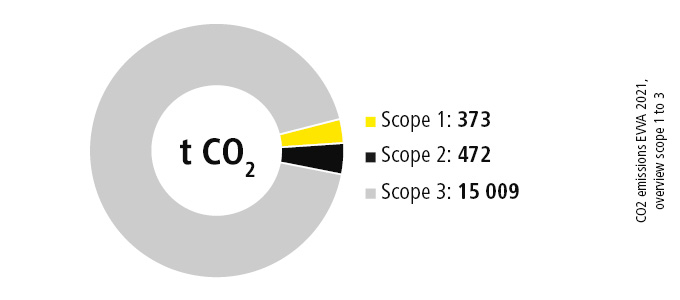
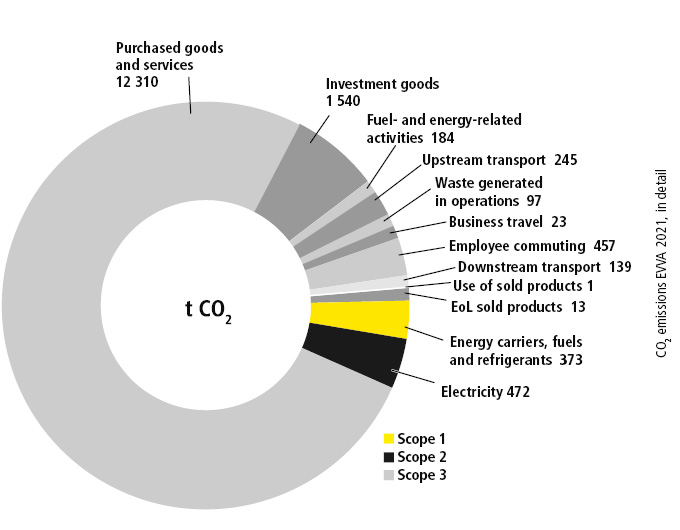
The energy demand of the EVVA headquarters converted into CO2 tons – as an overview and in detail. Source for conversion: CO2 check 2021 from external sustainability consultancy denkstatt. Emissions factor data basis: Austrian Environment Agency 2021 and Ecoinvent database V3. Assumptions/estimations for transport distances, commuter routes, and recycling data.
Improvements in the EVVA CO2 footprint
All EVVA emissions have decreased significantly in 2021 compared to 2020! The reasons for this are:
Scope 1: Decrease form 458 tons CO2 in 2020 to 373 tons in 2021
> Our gas consumption for heating has decreased by 22% due to modern systems (more air heat pumps, fewer gas boilers) and more efficient heating controls
> The cooling systems did not require additional refrigerants in 2021
Scope 2: Decrease from 1,044 tons CO2 in 2020 to 472 tons in 2021
In 2021, we were able to further increase the share of renewable energies in our electricity mix. In the next reporting period in 2022, this value will move towards zero CO2 thanks to the 100% green electricity share since January 1, 2022.
Scope 3: Decrease from 21,493 tons CO2 in 2020 to 15,009 tons in 2021
Since the last CO2 analysis in 2020, EVVA has been able to save 30% in Scope 3. The main reason for this is that the brass manufacturers are using far more scrap in production - which has significantly reduced our largest Scope 3 source, “Purchased goods”. The brass rods that EVVA purchases from these manufacturers for the production of lock cylinders and key contain much more recycled material than before. This was already the case in 2020, but not calculated accordingly in the CO2 check at the time. The updated figures for the 2021 period already include these reduced Scope 3 amounts – they have decreased from 18,428 tons in 2020 to 12,310 tons in 2021.
Our path to climate neutrality – CO2 savings measures:
To reach the Green Deal and the EU’s goal of achieving climate neutrality by 2050 (or in Austria by 2040), comprehensive measures to reduce emission will need to be implemented in the coming years. Since scope 1 and 2 are usually under the direct control of a company, efforts should first be focused on these areas. At the same time, it is also important to increasingly consider scope 3 and to achieve a steering effect – for example, through regular communication in the supply chain, new or improved processes in production and product use, or a focus on regional suppliers. The fact that scope 3 should not be overlooked is emphasised by its largest share of emissions in virtually all companies. The pressure to provide information and implement changes in the overall economic supply chain, both from and to each individual company, will increase in the coming years. This will bring significant investments and challenges, but in return, innovative, more environmentally friendly, and more efficient technologies can be expected, which will pay off through improved competitiveness and positive effects on climate protection.
Status quo and goals
Regarding scope 1:
The goal, set in the previous reporting period, to reduce our overall energy consumption by 10% in 2024 through energy savings-measures is still being implemented. Our measures that affect scope 1 have a direct influence:
- Reducing heating requirements, for example through the integration of air compressors into the heating return circuit and more efficient heating controls or core activation
- Reducing CO2 emissions from the company fleet. EVVA is promoting the switch to electric vehicles when making new purchases, and CO2 emissions are a decision-making criterion. Although electric vehicles are not yet ideal for all purposes, such as field service on long distances, the range is getting better all the time. As more electric cars and fewer conventional cars are expected to be produced in the future, the trend is clearly towards electromobility. This will continuously reduce EVVA’s CO2 emission from the company fleet and the corresponding scope 1 share.
Regarding scope 2:
As of January 1, 2022, EVVA will source its electricity from external energy suppliers at 100% from renewable sources (from hydropower). This is in addition to our energy generation from solar power through our own photovoltaic system. Nonetheless, EVVA will continue to promote measures to use energy efficiently, such as goals in building control technology or leak repair.
Regarding scope 3:
EVVA will continuously analyse further scope 1-3 savings opportunities throughout its own supply and value chain and use them for climate neutrality goals.
Fulfilment date: 2030
How: The goal initially refers to the EVVA headquarters with the main production site (75% of production value creation in the entire company group). Our goal by 2030 is therefore, firstly, to operate the entire heating system and the fleet (Scope 1) CO2-neutral, and secondly, to source 100% of the purchased electricity from green electricity (Scope 2).
We want to achieve the Scope 1 target - i.e. neutralise the current 373 t - with these measures, among others:
- Integration of the air compressors into the heating return (savings potential 168,000 kWh, 41 t CO2). The existing waste heat from machines will thus be used far more effectively
- Use of heat pumps instead of gas boilers; expand central building control technology (savings potential 100,000 kWh, 23 t CO2)
- Renovation of several roof superstructures including thermal insulation at headquarters by 2024 (savings potential 50,000 kWh, 12 t CO2)
- Conversion to a CO2-neutral vehicle fleet (currently 15% e-vehicles at headquarters. By 2030, their share will rise sharply, see also text above)
And Scope 2 target (currently 472 t) with these measures:
- Eliminate leaks in the compressed air system (potential savings 160,000 kWh, 36 t CO2)
- Switch to 100% purchased green electricity from hydropower as of 1.1.2022 (will have a very positive impact for reporting period 2022)
- Further electricity savings targets (see text above)
Positive impacts: This would mean that EVVA headquarters would already have achieved the EU’s targeted climate neutrality foal for 2050 – and Austria’s for 2040 – in Scope 1 and 2 by 2030. Compensation to achieve this goal is to be avoided as far as possible; we want to achieve it above all through our own efforts.
Fulfilment date: 2030
How: The goal currently applies to the EVVA headquarters with the main production site (75% of production value added in the entire company group) and to the base year 2021. The current 15,009 tons in Scope 3 should be reduced by 35% by 2030. This will be done through:
- Further recycling of scrap into the production cycle for brass and other metals. This will further reduce the largest scope-3 share of EVVA, namely “Purchased goods”
- Commissioning of service providers who explicitly rely on renewable energy, such as cloud service providers or manufactures of purchased capital goods
- The joint commitment throughout the entire supply chain to achieve the EU’s Green Deal
Positive impacts: With this partial goal, an important step towards climate neutrality would also be achieved in Scope 3. While this scope is not within the direct sphere of influence, it accounts for the largest share of CO2 for most companies. If all companies reduce their impacts in Scope 1 and 2 responsibly and to the best of their ability, this will automatically also have a favourable impact on scope 3 of each company. And thus on the big international goal: a climate-neutral EU by no later than 2050.

 AT
AT
 DE
DE
 DE
DE
 UK
UK
 INT
INT
How would you like to share?